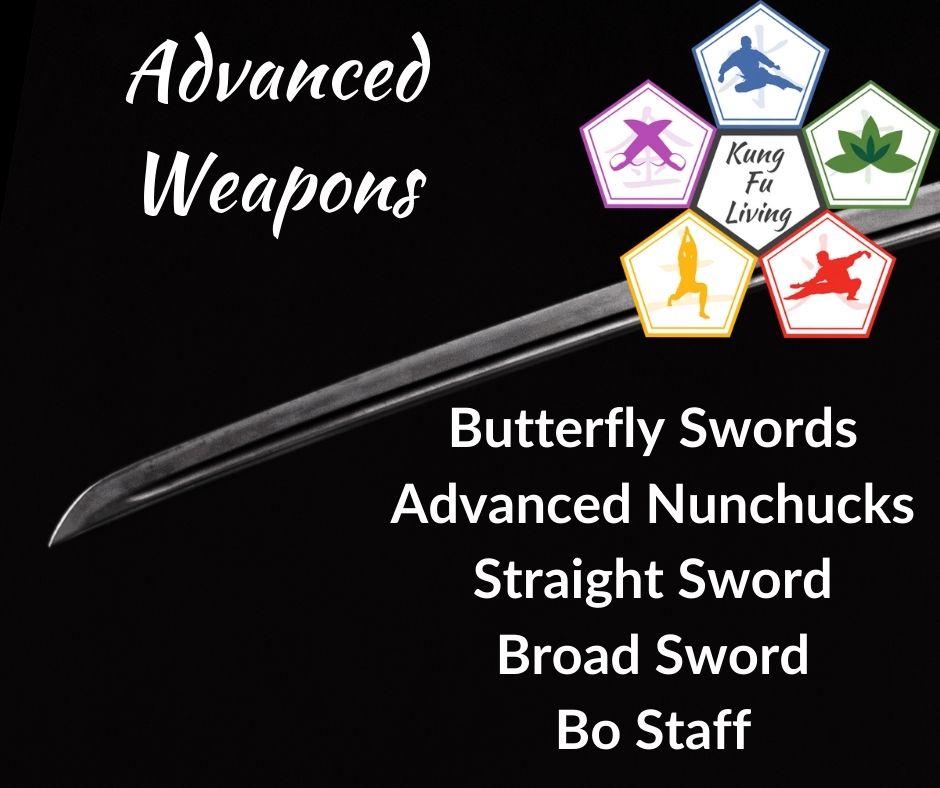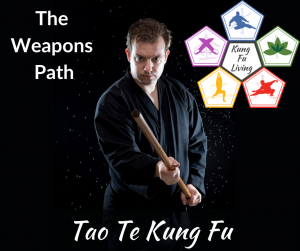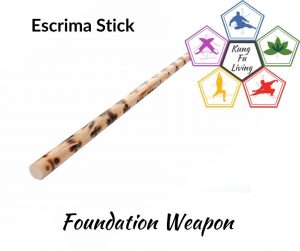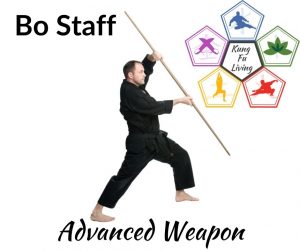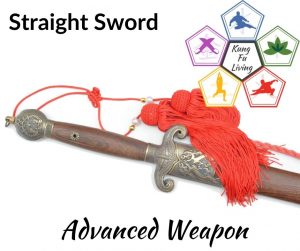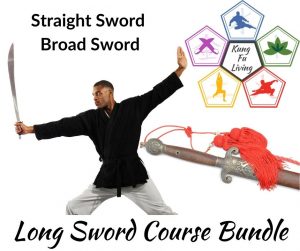- The Free App
- Masters Academy
- Kung Fu
- Weapons
- Meditation
- About
- Blogs
- Login
All 5 Advanced Weapon Courses
£70.00 £52.50
Broadsword – The broad sword is a brutal weapon, designed to be used on a battlefield with a continuous sweep and circling cuts, nobody would want to get in its way. The trick with such a weapon is to conserve your energy (your training weapon is likely to be polypropylene or such, so won’t have the weight of the real thing). If you stop and start with this weapon you will soon get tired as every acceleration and deceleration will sap your strength, but if you can keep it flowing, letting its weight and momentum do the work for you, it will feel like all you have to do is steer it.
Straight Sword – The straight sword develops good timing and speed of footwork. It enhances the intuitive exploitation of the openings in your opponent’s defence. The straight sword is a fast and aggressive weapon principally developed as a gentleman’s dueling weapon. While never having any significant weight behind a strike it tends to flicker with deadly results. The prime defense with this sword is to deflect even as you attack yourself. You can perform all the straight sword techniques with a simple walking stick or cane, making this weapon form very adaptable.
Butterfly Swords – The butterfly swords develop fast, ambidextrous attacking skills and agile, multidirectional footwork. They teach you to aggressively close distance and overwhelm your opponents with speed and unpredictable attacks.
Bo Staff – The Bo staff is the weapon with the greatest reach advantage over any other weapon in the system. If used properly and with correct positioning, you can keep opponents at bay while delivering powerful attacks from a safe distance. The Bo staff is also held in a central grip in order to attack with both ends and overwhelm your opponent at a shorter distance. The two ways of staff fighting are comprehensively covered in this program.
Advanced Double Nunchucks – The nunchaku is most widely used in martial arts as a training weapon, since it allows the development of quicker mind / body coordination and teaches 3 dimensional movements and patterns that also appear in unarmed kung fu combinations.
Broadsword – The broadsword is unlikely to be something you will use in real self defence but the neurological patterns developed through learning this broadsword training program will augment all other weapons training and unarmed techniques. The use of continuous momentum is particularly vital in understanding how to use your own mass but also how to conserve your strength.
The broad sword is a brutal weapon, designed to be used on a battlefield with a continuous sweep and circling cuts, nobody would want to get in its way. The trick with such a weapon is to conserve your energy (your training weapon is likely to be polypropylene or such, so won’t have the weight of the real thing). If you stop and start with this weapon you will soon get tired as every acceleration and deceleration will sap your strength, but if you can keep it flowing, letting its weight and momentum do the work for you, it will feel like all you have to do is steer it.
- The deflecting blocks that seamlessly integrate with the sweeping strikes
- The full set of strikes used in broadsword fighting and how to maximize their power
- The tactical use of continuous momentum to minimize effort and prioritize speed and efficiency
- Techniques to utilize optimal timing and targeting
- Specialized stepping and footwork techniques to best tactically use the momentum of the sword
- The overall strategy for finishing any real fight in the shortest possible time for your safety
Straight Sword – The straight sword develops good timing and speed of footwork. It enhances the intuitive exploitation of the openings in your opponent’s defence.
The straight sword is a fast and aggressive weapon principally developed as a gentleman’s dueling weapon. While never having any significant weight behind a strike it tends to flicker with deadly results. The prime defense with this sword is to deflect even as you attack yourself. You can perform all the straight sword techniques with a simple walking stick or cane, making this weapon form very adaptable.
- The light deflecting parries suited to the weight and speed of the weapon
- The full set of cuts and thrusts used in sword fighting and how to accurately apply them
- Techniques used tactically to open up your opponent for your counter strike
- Stance and fast footwork to optimize speed and timing
- Use of the straight thrust for anatomically precise targeting and winning strategy
- The overall strategy for finishing any real fight in the shortest possible time for your safety
Butterfly Swords – The butterfly swords develop fast, ambidextrous attacking skills and agile, multidirectional footwork. They teach you to aggressively close distance and overwhelm your opponents with speed and unpredictable attacks.
The Butterfly Swords are likely more formal versions of large Chinese meat cleavers, rather than military weapons. They are large bladed, top-heavy weapons that can deliver a powerful cleaving strike but are also effective at somewhat lighter cutting motions due to their shortness. Generally used in pairs, they are excellent close combat weapons thought to have been used by post-1800 civilian militia as they are easy to conceal and carry.
- The powerful double blocks used to defend against heavier, bigger weapons
- The full set of smooth and accurate cuts and thrusts used with these short aggressive swords
- Techniques used tactically to open up your opponent for your counter strikes
- Fast and multidirectional footwork to optimize speed and timing
- Use of the short blades to change cutting direction mid-strike to overwhelm your opponent’s defences
- The overall strategy for finishing any real fight in the shortest possible time for your safety
Bo Staff – The Bo staff is the weapon with the greatest reach advantage over any other weapon in the system. If used properly and with correct positioning, you can keep opponents at bay while delivering powerful attacks from a safe distance. The Bo staff is also held in a central grip in order to attack with both ends and overwhelm your opponent at a shorter distance. The two ways of staff fighting are comprehensively covered in this program.
The Bo staff has been used since the beginning of recorded history, often with a metal stud at the end. When used in real combat they tend to be on the heavier side. Many modern Bo staffs are very light with tapered ends. They are often used more for demonstration and performance. The lighter weight and size of the staff means it is easier to spin and throw. The Bo staff techniques taught in Tao Te Kung Fu are for fighting rather than performance and are done with a larger and heavier staff. Some techniques can also be practiced with a spear to a certain degree due to the similarity in the weapons.
- How to use the Bo Staff to shield your entire body
- Circular strikes from the long grip
- How to use circular strikes as redirecting blocks
- Powerful thrusts to different heights and targets
- Close grip blocking and striking techniques for close range
- Use of stepping to close range and engage close grip strategy
Advanced Double Nunchucks – The nunchaku is most widely used in martial arts as a training weapon, since it allows the development of quicker mind / body coordination and teaches 3 dimensional movements and patterns that also appear in unarmed kung fu combinations.
The two sections of the weapon are commonly made out of wood, while the link is a cord or a metal chain. Modern-day nunchaku can be made from metal, plastic or fiberglass and bear in mind that possession of them is illegal in some countries, except for use in martial arts schools. Foam or plastic Nunchucks are generally available for safer training and we indeed recommend that you learn with them.
The exact origin of nunchaku is unclear, it is often suggested that they were adapted by Okinawan farmers from a non-weapon rice-flail implement for threshing rice. It is very common that a farming community, who are under military dictatorship and forbidden from carrying weapons, will adapt their agricultural hand tools to use as weapons.
Though I’m told there are police officers who use nunchucks instead of side-handled batons, it is unlikely that you will have need of these skills to defend yourself in a real confrontation. That shouldn’t stop you from learning and enjoying these skills. Nunchucks are simply fun in the way that people enjoy juggling, but the improved coordination and neurological patterns developed will undoubtedly overflow to your other martial arts practice and other areas of life.
- How to bounce the nunchucks off your body for fast changes of direction
- Spinning and figure eight spinning in vertical and horizontal planes
- The use of alternating double strikes
- Asymmetrical spins and figure eight spins with fast body spins and steps
- Complex figure eight spins while turning and transferring the strike directions
- Hand rolling nunchucks with both hands while constantly changing spin direction
You will need:
Some space, depending on the height of your ceiling, you might need to practice outside.
The appropriate practice weapons, we recommend you DO NOT learn these forms with real weapons.
These forms are short enough to be remembered (this is martial arts, not memory training), and should be practiced until they can be done without thinking.
The program is set out for you to train every day using several short videos. Adding to your skills in easy to follow steps, you will build superb skills that will become second nature.
Some videos are called Repeat Drills, these are of simple techniques that you need to learn so that you can do them without thinking. Once you press play, they will simply repeat continuously until you hit stop. This will enable you to practice each movement many times with a constant visual reference to help you get it right. You don’t want to practice until you get it right, you want to practice until you can’t get it wrong.
It is tempting to rush ahead, but you will find that to learn these skills thoroughly, it is best that you master each part as you go even if that means repeating the same day several times. Excellence takes patience and determination. Remember “Kung Fu” means “mastery through discipline.”
You may also like…
Related products
Privacy Overview
Necessary cookies are absolutely essential for the website to function properly. This category only includes cookies that ensures basic functionalities and security features of the website. These cookies do not store any personal information.
Any cookies that may not be particularly necessary for the website to function and is used specifically to collect user personal data via analytics, ads, other embedded contents are termed as non-necessary cookies. It is mandatory to procure user consent prior to running these cookies on your website.


